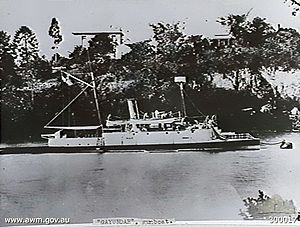HMQS Gayundah

HMQS Gayundah in 1886
|
|
| History | |
|---|---|
|
|
|
| Name: | Gayundah |
| Namesake: | Aboriginal word for "lightning" |
| Builder: | Sir W.G. Armstrong, Mitchell & Co, Newcastle-on-Tyne |
| Cost: | GB£35,000 |
| Launched: | 13 May 1884 |
| Commissioned: | 28 October 1884 |
| Decommissioned: | 1921 |
| Fate: | Breakwater since 1958 |
| General characteristics | |
| Class and type: | Armstrong type B1 flat-iron gunboat |
| Displacement: | 360 tons |
| Length: | 120 ft (37 m) |
| Beam: | 26 ft (7.9 m) |
| Draught: | 9 ft 6 in (2.90 m) |
| Installed power: | 400 ihp (298 kW) |
| Propulsion: | 2 shaft horizontal direct action compound steam engines |
| Speed: | 10.5 knots (19.4 km/h; 12.1 mph) |
| Range: | 700 to 800 mi (1,100 to 1,300 km) |
| Endurance: | 75 tons of coal |
| Complement: | 55 |
| Armament: |
|
HMQS Gayundah was a flat-iron gunboat operated by the Queensland Maritime Defence Force and later the Royal Australian Navy (as HMAS Gayundah). She entered service in 1884 and was decommissioned and sold to a civilian company in 1921. She then served as sand and gravel barge in Brisbane until the 1950s, when she was scrapped. In 1958, Gayundah was run aground at Woody Point near Redcliffe, to serve as a breakwater structure.
In the 1870s the British military presence in Australia had declined and the individual colonies had begun planning for their own defence, culminating in the Jervois-Scratchley reports. Amidst concerns about Russian influence in the Pacific, in 1884 the Queensland Maritime Defence Force was established. The same year, the colony placed an order for its first vessels: a torpedo boat, HMQS Mosquito, and two gunboats, Gayundah and HMQS Paluma. Both Gayundah and Paluma belonged to a class of vessels that were built to a type B1 flat-iron gunboat design by builders Sir W.G. Armstrong, Mitchell & Co. The very similar HMVS Albert was also built in 1884 and served with the colony of Victoria.
The ship displaced 360 tons, and she was 120 feet (37 m) long, had a 26-foot (7.9 m) beam and a draught of 9.5 feet (2.9 m).Gayundah was propelled by horizontal direct action compound steam engines, which drove two screws that were capable of producing 400 ihp (298 kW), giving her a range of 700 to 800 mi (1,100 to 1,300 km) at a cruising speed of 10.5 knots (19.4 km/h; 12.1 mph). She also had sails to back up her engines. As built, her armament consisted of one BL 8-inch (203.2 mm) gun, one BL 6-inch (152.4 mm) gun, two 1.5-inch Nordenfelt guns and two machine guns. She had a complement of 55 men all ranks; her name was an Aboriginal word for "lightning".
...
Wikipedia
